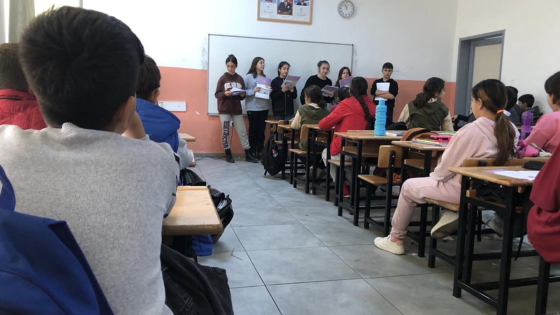Each student influences his or her classmates – not only through knowledge spillovers and how teachers respond to him/her, but also in how he/she affects classroom standards. A less disciplined student is more likely to disrupt his/her classmates, forcing the teacher to devote more time in class to disciplining rather than transmitting knowledge. Therefore a student’s performance in school may be influenced by the characteristics and behaviour of his/her peers.
If these peer group effects are substantial, government policy may exploit them by optimally grouping students in different classrooms to achieve desired socioeconomic outcomes.
The rekindled interest in non-market interactions is motivated in part by recent theoretical developments in the economics literature which demonstrate that the composition of peer groups affect the optimal organisation of schools, neighbourhoods, and other arenas where agents interact. Recent theoretical analyses of school choice showing that the introduction of vouchers could increase competition and improve the efficiency of public schools rely on the existence of positive peer effects (e.g. Epple and Romano 1998, Nechyba 2000). Peer group effects have also played a prominent role in policy debates concerning ability tracking, school desegregation, affirmative action, school busing, magnet schools, and Moving to Opportunity programmes. For example, if low ability students benefit from the presence of superior peers, while high ability students are not harmed by the presence of disadvantaged peers, then mixing students of different ability levels can generate social gains.
However, as noted by Manski (1993, 2000) and Moffitt (2001), it is important to separately identify:
- Peer or endogenous effects – those determined by schooling, and
- contextual or exogenous effects – those determined by other factors.
This is because endogenous effects generate a social multiplier while contextual or exogenous effects do not.
In the context of education, this means that a special programme targeting some individuals will have multiplier effects.
- The individual affected by the programme will improve his/her performance at school and influence the performances of his/her peers, which, in turn, will affect those of their peers, and so on.
- If only contextual effects are present, then there will be no social multiplier effects from any policy affecting only the “context” (for example, improving the quality of the teachers at school).
Therefore, the identification of these two effects is of paramount importance for policy purposes. Another important policy issue in the estimation of social interactions is the separation between peer effects and confounding effects. Indeed, the formation of peer group is not random and individuals do select into groups of friends. It is therefore important to separate the endogenous peer effects from the correlated effects, i.e. the same educational activities may be due to common unobservable variables (such as, for example, the fact that individuals from the same network like bowling together) faced by individuals belonging to the same network rather than peer effects. This is also very important for educational policies since, for example, if the low grades of some students is due to the fact that teenagers like to bowling together, then obviously the implications are very different than if it were due to peer effects.
New insights on peer effects
Our recent research uncovers peer effects in education as distinct from the contextual and other correlated influences. Our econometric strategy uses the topological structure of social networks as well as network fixed effects to identify each of these effects separately.
Our analysis is made possible by the use of a unique database on friendship networks from the National Longitudinal Survey of Adolescent Health (AddHealth). The AddHealth database has been designed to study the impact of the social environment (i.e. friends, family, neighbourhood and school) on adolescents' behaviour in the US by collecting data on students in grades 7-12 from a nationally representative sample of roughly 130 private and public schools in years 1994-95 (wave I). A subset of adolescents selected from the rosters of the sampled schools, was then interviewed again in 1995-96 (wave II), in 2001-2 (wave III), and again in 2007-2008 (wave IV). For our purposes, the most interesting aspect of the AddHealth data is the friendship information, which is based upon actual friend nominations. It is collected at wave I, i.e. when individuals were at school. Indeed, pupils were asked to identify their best friends from a school roster (up to five males and five females). As a result, we can reconstruct the whole geometric structure of the friendship networks.
In Calvó-Armengol et al. (2008), we exploit such information to test a peer-effect model which relates analytically equilibrium behaviour to network location. This analysis shows that the structure of friendships ties is an important, and so far unnoticed, determinant of a pupil performance at school. In Patacchini et al. (2011), we follow this line of research by exploiting the other AddHealth waves in order to investigate whether such effect is carried over time. Indeed, the longitudinal structure of the survey provides information on both respondents and friends during the adulthood. In particular, the questionnaire of wave IV contains detailed information on the highest education qualification achieved.
We analyse the impact of the friends' educational attainment on an individual's educational attainment where they are identified as friends during school and in to adulthood. We find that peer effects in education are not only strong but also persistent over time. We find that the most relevant peers are the friends people make in grade 10-12, from when they are around 15 years old. This suggests that individuals are more likely to work towards and apply to college if this choice is popular among their peers, especially in the last years at school. This could represent the effect of contagion and collective socialisation and mean that any education policy targeting specific individuals will have multiplier effects.
References
Calvó-Armengol, A, E Patacchini, and Yves Zenou (2008), “Peer effects and social networks in education”, CEPR Discussion Paper 7060, published in the Review of Economic Studies 2009.
Epple, D and RE Romano (1998), “Competition between private and public schools: Vouchers and peer group effects”, American Economic Review, 88:33-62.
Nechyba, TJ (2000), “Mobility, targeting, and private-school vouchers”, American Economic Review, 90:130-146.
Manski, CF (1993), “Identification of endogenous effects: The reflection problem”, Review of Economic Studies, 60:531-542.
Manski, CF (2000), “Economic analysis of social interactions”, Journal of Economic Perspectives, 14:115-136.
Moffitt, R (2001), “Policy interventions low-level equilibria, and social interactions”, in S Durlauf and P Young (eds.), Social Dynamics, MIT Press,45-82.
Patacchini, E, E Rainone, and Y Zenou (2011), “Dynamic aspects of teenage friendships and educational attainment”, CEPR Discussion Paper 8223.


